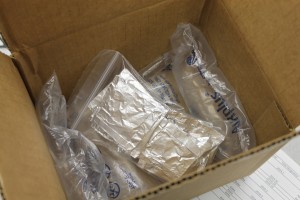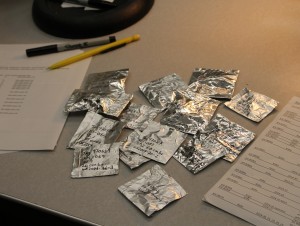Author: C. Funk | University at Buffalo | November 28, 2014
Fourteen little foil packets of charcoal, burned grass, and charred wood have headed off to the W.M. Keck Carbon Cycle Accelerator Mass Spectrometry Laboratory. They’ll compete with Black Friday online shopping packages for space in the UPS plane, but I packed them tightly in a strong little box.

Once they arrive at the Keck CCAMS lab, Dr. John Southon will prepare the samples for analysis. They’ll go into the accelerator where they’ll be ionized and become negatively charged carbon atoms. Then, they’ll be accelerated to become positively charged atoms shooting along a path specific to carbon atoms. Carbon isotope 12, 13, and 14 atoms will deflect from the carbon path at different angles and they’ll be counted as they pass detectors in the accelerator. The counts will provide Dr. Southon with a ratio of stable and unstable carbon isotopes – and because unstable carbon 14 decays at a known rate from a known proportion in organic material he can tell me how old the carbon samples are.
Our job in the archaeology lab will be to associate the dated carbon samples with the rest of the materials. Everything hinges on how responsibly we make these associations. The archaeological materials will be considered older, younger, or more or less the same age as the dated materials depending positioning in the excavation. Similarly dated plant materials from the pollen cores taken in the surrounding landscape will tie developments in the environment to cultural events. Our prehistoric food web models will be based on the dates we assign to archaeological faunal materials according to their proximity to dated carbon samples. And, defining the long-term history of Aleut use of southern Kiska Island relies on the dates for all of the large and small sites we located during the summer’s field work.
We sent seven samples from KIS-050, a newly recorded prehistoric Aleut village site that we mapped and intensively tested during the Summer 2014 season. We are dating materials from a series of middens and house floors. The hope is that we have a strong temporal sequence and that all of the excavated materials can be placed in time ranges of hundreds of years.

I sent seven samples from several other newly recorded Aleut village sites and smaller occupations that we located during the archaeological survey. We’ll know when these places were used at least one time in the past, but we won’t know for how long they were used by Aleuts, or for what. The dates from the smaller shovel tests we excavated on survey give us a broad idea of how intensively Aleuts used the whole area over hundreds of years.
These fourteen hard won little packets of charred material separate us from the old days of Aleutian archaeology, when everything was known simply as before, and nothing could be tracked over the lifetimes of individuals and families living in an ever-changing world.